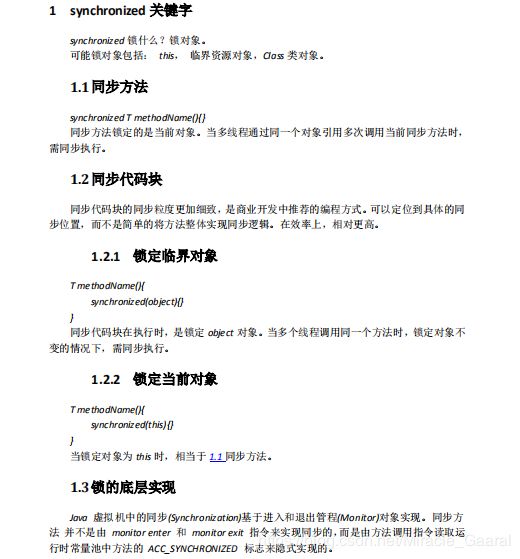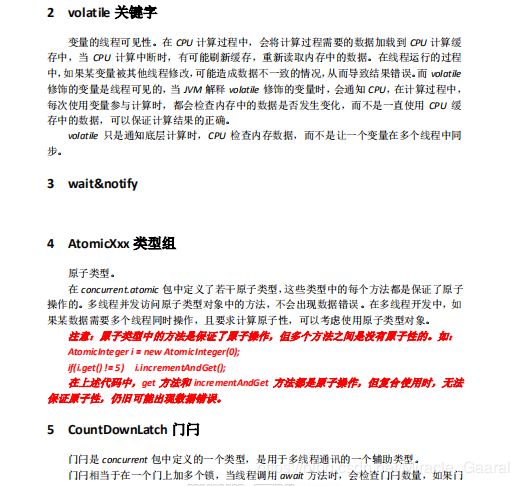高并发编程和线程池----同步/多线程基础知识
一.同步
/**
* synchronized关键字
* 同步方法 - 原子性
* 加锁的目的: 就是为了保证操作的原子性
*/
package concurrent.t01;
public class Test_03 implements Runnable {
private int count = 0;
@Override
public /* synchronized */ void run() {
System.out.println(Thread.currentThread().getName()
+ " count = " + count++);
}
public static void main(String[] args) {
Test_03 t = new Test_03();
for(int i = 0; i < 5; i++){
new Thread(t, "Thread - " + i).start();
}
}
}
/**
* synchronized关键字
* 同步方法 - 同步方法和非同步方法的调用
* 同步方法只影响锁定同一个锁对象的同步方法。不影响其他线程调用非同步方法,或调用其他锁资源的同步方法。
*/
package concurrent.t01;
public class Test_04 {
Object o = new Object();
public synchronized void m1(){ // 重量级的访问操作。
System.out.println("public synchronized void m1() start");
try {
Thread.sleep(3000);
} catch (InterruptedException e) {
e.printStackTrace();
}
System.out.println("public synchronized void m1() end");
}
public void m3(){
synchronized(o){
System.out.println("public void m3() start");
try {
Thread.sleep(1500);
} catch (InterruptedException e) {
e.printStackTrace();
}
System.out.println("public void m3() end");
}
}
public void m2(){
System.out.println("public void m2() start");
try {
Thread.sleep(1500);
} catch (InterruptedException e) {
e.printStackTrace();
}
System.out.println("public void m2() end");
}
public static class MyThread01 implements Runnable{
public MyThread01(int i, Test_04 t){
this.i = i;
this.t = t;
}
int i ;
Test_04 t;
public void run(){
if(i == 0){
t.m1();
}else if (i > 0){
t.m2();
}else {
t.m3();
}
}
}
public static void main(String[] args) {
Test_04 t = new Test_04();
new Thread(new Test_04.MyThread01(0, t)).start();
new Thread(new Test_04.MyThread01(1, t)).start();
new Thread(new Test_04.MyThread01(-1, t)).start();
}
}
/**
* synchronized关键字
* 同步方法 - 多方法调用原子性问题(业务)
* 同步方法只能保证当前方法的原子性,不能保证多个业务方法之间的互相访问的原子性。
* 注意在商业开发中,多方法要求结果访问原子操作,需要多个方法都加锁,且锁定统一个资源。
*
* 一般来说,商业项目中,不考虑业务逻辑上的脏读问题。
*/
package concurrent.t01;
import java.util.concurrent.TimeUnit;
public class Test_05 {
private double d = 0.0;
public synchronized void m1(double d){
try {
// 相当于复杂的业务逻辑代码。
TimeUnit.SECONDS.sleep(2);
} catch (InterruptedException e) {
e.printStackTrace();
}
this.d = d;
}
public double m2(){
return this.d;
}
public static void main(String[] args) {
final Test_05 t = new Test_05();
new Thread(new Runnable() {
@Override
public void run() {
t.m1(100);
}
}).start();
System.out.println(t.m2());
try {
TimeUnit.SECONDS.sleep(3);
} catch (InterruptedException e) {
e.printStackTrace();
}
System.out.println(t.m2());
}
}
/**
* synchronized关键字
* 同步方法 - 调用其他同步方法
* 锁可重入。 同一个线程,多次调用同步代码,锁定同一个锁对象,可重入。
*/
package concurrent.t01;
import java.util.concurrent.TimeUnit;
public class Test_06 {
synchronized void m1(){ // 锁this
System.out.println("m1 start");
try {
TimeUnit.SECONDS.sleep(2);
} catch (InterruptedException e) {
e.printStackTrace();
}
m2();
System.out.println("m1 end");
}
synchronized void m2(){ // 锁this
System.out.println("m2 start");
try {
TimeUnit.SECONDS.sleep(1);
} catch (InterruptedException e) {
e.printStackTrace();
}
System.out.println("m2 end");
}
public static void main(String[] args) {
new Test_06().m1();
}
}
/**
* synchronized关键字
* 同步方法 - 继承
* 子类同步方法覆盖父类同步方法。可以指定调用父类的同步方法。
* 相当于锁的重入。
*/
package concurrent.t01;
import java.util.concurrent.TimeUnit;
public class Test_07 {
synchronized void m(){
System.out.println("Super Class m start");
try {
TimeUnit.SECONDS.sleep(1);
} catch (InterruptedException e) {
e.printStackTrace();
}
System.out.println("Super Class m end");
}
public static void main(String[] args) {
new Sub_Test_07().m();
}
}
class Sub_Test_07 extends Test_07{
synchronized void m(){
System.out.println("Sub Class m start");
super.m();
System.out.println("Sub Class m end");
}
}
/**
* synchronized关键字
* 同步方法 - 锁与异常
* 当同步方法中发生异常的时候,自动释放锁资源。不会影响其他线程的执行。
* 注意,同步业务逻辑中,如果发生异常如何处理。
*/
package concurrent.t01;
import java.util.concurrent.TimeUnit;
public class Test_08 {
int i = 0;
synchronized void m(){
System.out.println(Thread.currentThread().getName() + " - start");
while(true){
i++;
System.out.println(Thread.currentThread().getName() + " - " + i);
try {
TimeUnit.SECONDS.sleep(1);
} catch (InterruptedException e) {
// TODO Auto-generated catch block
e.printStackTrace();
}
if(i == 5){
i = 1/0;
}
}
}
public static void main(String[] args) {
final Test_08 t = new Test_08();
new Thread(new Runnable() {
@Override
public void run() {
t.m();
}
}, "t1").start();
new Thread(new Runnable() {
@Override
public void run() {
t.m();
}
}, "t2").start();
}
}
/**
* volatile关键字
* volatile的可见性
* 通知OS操作系统底层,在CPU计算过程中,都要检查内存中数据的有效性。保证最新的内存数据被使用。
*
*/
package concurrent.t01;
import java.util.concurrent.TimeUnit;
public class Test_09 {
volatile boolean b = true;
void m(){
System.out.println("start");
while(b){}
System.out.println("end");
}
public static void main(String[] args) {
final Test_09 t = new Test_09();
new Thread(new Runnable() {
@Override
public void run() {
t.m();
}
}).start();
try {
TimeUnit.SECONDS.sleep(1);
} catch (InterruptedException e) {
// TODO Auto-generated catch block
e.printStackTrace();
}
t.b = false;
}
}
/**
* volatile关键字
* volatile的非原子性问题
* volatile, 只能保证可见性,不能保证原子性。
* 不是枷锁问题,只是内存数据可见。
*/
package concurrent.t01;
import java.util.ArrayList;
import java.util.List;
public class Test_10 {
volatile int count = 0;
/* synchronized */ void m(){
for(int i = 0; i < 10000; i++){
count++;
}
}
public static void main(String[] args) {
final Test_10 t = new Test_10();
List threads = new ArrayList<>();
for(int i = 0; i < 10; i++){
threads.add(new Thread(new Runnable() {
@Override
public void run() {
t.m();
}
}));
}
for(Thread thread : threads){
thread.start();
}
for(Thread thread : threads){
try {
thread.join();
} catch (InterruptedException e) {
// TODO Auto-generated catch block
e.printStackTrace();
}
}
System.out.println(t.count);
}
}
/**
* AtomicXxx
* 同步类型
* 原子操作类型。 其中的每个方法都是原子操作。可以保证线程安全。
*/
package concurrent.t01;
import java.util.ArrayList;
import java.util.List;
import java.util.concurrent.atomic.AtomicInteger;
public class Test_11 {
AtomicInteger count = new AtomicInteger(0);
void m(){
for(int i = 0; i < 10000; i++){
/*if(count.get() < 1000)*/
count.incrementAndGet();
}
}
public static void main(String[] args) {
final Test_11 t = new Test_11();
List threads = new ArrayList<>();
for(int i = 0; i < 10; i++){
threads.add(new Thread(new Runnable() {
@Override
public void run() {
t.m();
}
}));
}
for(Thread thread : threads){
thread.start();
}
for(Thread thread : threads){
try {
thread.join();
} catch (InterruptedException e) {
// TODO Auto-generated catch block
e.printStackTrace();
}
}
System.out.println(t.count.intValue());
}
}
/**
* synchronized关键字
* 锁对象变更问题
* 同步代码一旦加锁后,那么会有一个临时的锁引用执行锁对象,和真实的引用无直接关联。
* 在锁未释放之前,修改锁对象引用,不会影响同步代码的执行。
*/
package concurrent.t01;
import java.util.concurrent.TimeUnit;
public class Test_13 {
Object o = new Object();
int i = 0;
int a(){
try{
/*
* return i ->
* int _returnValue = i; // 0;
* return _returnValue;
*/
return i;
}finally{
i = 10;
}
}
void m(){
System.out.println(Thread.currentThread().getName() + " start");
synchronized (o) {
while(true){
try {
TimeUnit.SECONDS.sleep(1);
} catch (InterruptedException e) {
e.printStackTrace();
}
System.out.println(Thread.currentThread().getName() + " - " + o);
}
}
}
public static void main(String[] args) {
final Test_13 t = new Test_13();
new Thread(new Runnable() {
@Override
public void run() {
t.m();
}
}, "thread1").start();
try {
TimeUnit.SECONDS.sleep(3);
} catch (InterruptedException e) {
e.printStackTrace();
}
Thread thread2 = new Thread(new Runnable() {
@Override
public void run() {
t.m();
}
}, "thread2");
t.o = new Object();
thread2.start();
System.out.println(t.i);
System.out.println(t.a());
System.out.println(t.i);
}
}
/**
* synchronized关键字
* 常量问题
* 在定义同步代码块时,不要使用常量对象作为锁对象。
*/
package concurrent.t01;
public class Test_14 {
String s1 = "hello";
String s2 = new String("hello"); // new关键字,一定是在堆中创建一个新的对象。
Integer i1 = 1;
Integer i2 = 1;
void m1(){
synchronized (i1) {
System.out.println("m1()");
while(true){
}
}
}
void m2(){
synchronized (i2) {
System.out.println("m2()");
while(true){
}
}
}
public static void main(String[] args) {
final Test_14 t = new Test_14();
new Thread(new Runnable() {
@Override
public void run() {
t.m1();
}
}).start();
new Thread(new Runnable() {
@Override
public void run() {
t.m2();
}
}).start();
}
}
/**
* 门闩 - CountDownLatch
* 可以和锁混合使用,或替代锁的功能。
* 在门闩未完全开放之前等待。当门闩完全开放后执行。
* 避免锁的效率低下问题。
*/
package concurrent.t01;
import java.util.concurrent.CountDownLatch;
import java.util.concurrent.TimeUnit;
public class Test_15 {
CountDownLatch latch = new CountDownLatch(5);
void m1(){
try {
latch.await();// 等待门闩开放。
} catch (InterruptedException e) {
e.printStackTrace();
}
System.out.println("m1() method");
}
void m2(){
for(int i = 0; i < 10; i++){
if(latch.getCount() != 0){
System.out.println("latch count : " + latch.getCount());
latch.countDown(); // 减门闩上的锁。
}
try {
TimeUnit.MILLISECONDS.sleep(500);
} catch (InterruptedException e) {
// TODO Auto-generated catch block
e.printStackTrace();
}
System.out.println("m2() method : " + i);
}
}
public static void main(String[] args) {
final Test_15 t = new Test_15();
new Thread(new Runnable() {
@Override
public void run() {
t.m1();
}
}).start();
new Thread(new Runnable() {
@Override
public void run() {
t.m2();
}
}).start();
}
}

